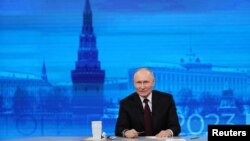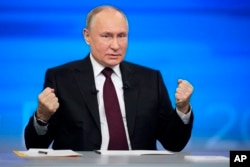Russian President Vladimir Putin once again put himself in the public spotlight with his year-end televised press conference at Moscow’s Gostinyy Dvor exhibition center on December 14.
The presser was the first of its kind since Russia invaded Ukraine on February 24, 2022, with last year’s event canceled for the first time in 10 years amid Ukrainian successes on the battlefield.
On Ukraine, Putin capitalized on talks about a stalemate following Ukraine’s lackluster summer counteroffensive, and fears that Western support to Ukraine could drop off, to claim he believes in a Russian victory.
Over the course of four hours, Putin took questions from the media and the public, using the platform to spread disinformation not only about Russia’s invasion of Ukraine, but also about the war in Gaza, the situation at home, and beyond.
Polygraph.info outlines some of the lies and distortions from that marathon event.
Putin falsely denies his destruction in Ukraine is comparable to Gaza
Putin attempted to use the Israel-Hamas war as a point of contrast for his own invasion, claiming the “catastrophe” in the Gaza Strip bore no resemblance to the destruction Russian forces had unleashed in Ukraine.
“Take a look at the special military operation and what’s happening in Gaza — feel the difference. There’s nothing like this in Ukraine,” Putin said.
However, there is no apples-to-apples comparison between Ukraine and the Gaza Strip due to the sheer size difference and theater of operations — Ukraine is roughly 603,700 square kilometers, and the Gaza Strip is 365 square kilometers. Still, Russia has unleashed comparable levels of destruction in cities, towns and villages across Ukraine.
As a direct result of Russian military aggression, at least nine large and small cities in Ukraine have been destroyed.
Reports indicate roughly 90% of residential buildings in Mariupol, a Russian-occupied port city in Ukraine’s south, were damaged or destroyed. Another city, Bakhmut, in Ukraine’s east, has been left in ruins.
The city of Popasna, in Russian-occupied Luhansk, was so thoroughly decimated, it has effectively been wiped from the map.
Misleading comparisons have also been drawn between the U.N.’s verified civilian death toll in Ukraine, and figures released by the Hamas-controlled Gaza Health Ministry, which does not distinguish between civilians and combatants.
The U.N. estimates roughly 10,000 civilians were killed in Ukraine, although Ukraine says that figure is 10 times higher. The Gaza Health Ministry puts the Palestinian death toll at 18,600.
However, varying estimates put Russian combat losses in Ukraine at 315,000, and Ukrainian losses at about 70,000.
Putin again tries to blame West for his invasion
Putin returned to the oft-repeated lie that Russia was forced to invade Ukraine to stop the expansion of the North Atlantic Treaty Organization, an intergovernmental military alliance between 31 member states. He also falsely claimed the West carried out a coup in Ukraine in 2014.
“[The coup], plus the unrestrained desire to crawl to our borders, capturing Ukraine in NATO — all this led to this tragedy.”
However, there was no coup in Ukraine. Ukraine’s then Russia-aligned President Viktor Yanukovych abandoned his post as Ukraine’s president and fled to Russia amid mass protests against his refusal to sign an association agreement with the European Union, not because of machinations by his country's political or military elite, or the West.
Russia’s war against Ukraine started in 2014 when Moscow annexed Crimea and fomented conflict in Ukraine’s eastern provinces. At that time, Ukraine had legally codified its status as a non-aligned country, which ruled out NATO membership.
Even after Russia’s illegal annexation of Crimea, NATO pursued de-escalation with Moscow, although talk of Ukraine joining NATO picked up after Russia launched and carried out a proxy war in eastern Ukraine.
Ironically, Russia’s invasion of Ukraine led Finland and Sweden to seek NATO membership, which prompted a muted response from Moscow.
No, Zelenskyy does not support Nazis
Putin has long maintained the false claim that Russia is engaged in “a special military operation” to “demilitarize and “denazify” Ukraine.
During the year-end presser, he stated:
"When the head of today's Kyiv administration, in front of the whole world, gives a standing ovation to a former SS soldier who was directly involved in the Holocaust, the extermination of one and a half million Jews in Ukraine, Russians and Poles … is this not a manifestation of Nazism? Therefore, the issue of denazification is relevant.”
Putin was referring to an address Ukrainian President Volodymyr Zelenskyy gave to a joint session of the Canadian Parliament on September 22.
During that session Anthony Rota, speaker of the House of Commons, identified one of the attendees, 98-year-old Yaroslav Hunka, as a Ukrainian veteran of World War II. Rota called him a hero, while Zelenskyy and others in attendance gave Hunka a standing ovation.
Unbeknownst to Zelenskyy and those in attendance, Hunka had served in the 14th Waffen Grenadier Division of the SS, the military wing of the Nazi Party.
Canada’s leadership expressed embarrassment and apologized for the incident.
Born to a Russian-speaking Jewish family, Zelenskyy is not a Nazi, and his family directly suffered from Nazi extermination policies. His great-grandfather and three great-uncles were killed in the Nazi Holocaust during WWII.
Like Russia and Europe, far-right extremist groups exist in Ukraine, although in Ukraine they have no real political power.
Ukraine’s Black Sea Costal City Odesa is not Russian
Putin went on to falsely claim that Odesa is a Russian city. Russia has regularly shelled it since February 2022.
"Odessa is a Russian city. We know this. Everyone knows this. "
Modern Odesa was established as the Tatar fortress in the 14th century under the name Khadzhibey. Throughout history, the city belonged to Lithuania, Poland and Turkey.
Russia took the fortress by force in 1792 to build it anew with the addition of a naval base and a commercial quay. In 1795, the port was renamed Odesa for the ancient Greek colony of Odessos, believed to be the city’s predecessor.
For 126 years, from 1792 to 1918, Odesa was part of the Russian Empire.
But for the last 105 years, the city has been part of Ukraine.
First, the independent Ukrainian National Republic from 1918 to 1920, then the Ukrainian Soviet Socialist Republic from 1921 to 1991, and finally, sovereign Ukraine from 1991 to date.
Putin seems to base his claim on the 19th century Russian imperial propaganda myth that the city on the site of modern Odesa was founded 200 years ago by Catherine the Great, empress of Russia.
But the historians of the Ukrainian Institute of National Memory, say such a myth was convenient for Russia's territorial claims as it "created the impression that civilization came to these territories along with their conquest by the Russian Empire."
Odesa has always been multiethnic, and no census ever showed a significant Russian ethnic majority there. According to the first and last census of the Russian Empire in 1897, 49.09% of the population were Russians, 30.83% were Jews and 9.39% were Ukrainians.
Over the centuries, the share of Russians in Odesa had been steadily decreasing. It came down to 39.97% in 1926 and 30.88% in 1939.
By 2001, Ukrainians became the majority of the Odesa population.
The share of ethnic Ukrainians rose to 61,7%, while Russians fell to 29%.
According to a 2015 study by the International Republican Institute, 68% of Odessa residents are ethnic Ukrainians, and 25% are ethnic Russians.
Russia’s New History Textbooks Are the Epitome of Historic Revisionism
When Alexander Gamov, a journalist with the Moscow tabloid Komsomolskaya Pravda, asked why history textbooks were replaced with a new edition in 2023, Putin said that the updated version, unlike the old one, is truthful and does not reflect anyone’s interests:
“[T]extbooks must correspond to the truth; they must be truthful and not serve someone else’s interests, as we used to have them.”
In August of this year, the Russian education ministry presented two new textbooks of contemporary Russian history and world history courses, that replaced the previous editions.
These new history books are full of Kremlin propaganda and pseudo-history designed to promote Russian patriotism.
Below are a few examples.
From a Russian history textbook:
"The confrontation between Russia and the West escalated even more in the early 2020s... The shelling of Donbas became more frequent."
That is not true. The United Nations Human Rights Monitoring Mission in Ukraine reported in 2022 that before Russia’s full-fledged invasion in February 2022, the number of war-related civilian casualties in Donbas has been steadily declining. It fell from 128 in 2018 to 85 in 2019, then to 61 in 2020, and to 36 in 2021.
From a Russian history textbook:
"The United States has become the main beneficiary of the Ukrainian conflict. They managed to impose their expensive gas and other resources on Europe.”
Contrary to this assertion, Eurostat, the statistical office of the European Union (EU), reported on July 4 this year that the share of American gas in EU countries' imports fell during the first year of the Russian-Ukrainian war:
“As for liquefied natural gas, Russia (18.1%) was the EU's second-largest supplier, behind the United States (48.6%), in the first quarter of 2022. Fast-forward to the first quarter of 2023, the share of Russia dropped by 4.9 pp. At the same time, the shares of Norway (+6.5 pp), Qatar, and Algeria (both +2.4 pp) all increased while the share of the United States dropped by 8.4 pp.”
From a Russian history textbook:
“The United States is determined to fight to the last Ukrainian.”
No outside power can force Ukrainians against their will to fight Russia.
For centuries before the U.S. had any influence, the Ukrainians have fought Russia for their freedom.
The Ukrainian Independent Research Organization Rating polling agency’s survey showed that the number of Ukrainians who believe that “victory in the war is the liberation of all its territories, including Crimea and occupied Donbas, has increased from 74% in March to 85% in November 2022."
Ilko Kucheriv Democratic Initiatives Foundation, a Ukrainian independent think tank, reported that 70% of surveyed Ukrainians agreed that “it is important to see all territories liberated from the enemy in order to call such an end to the war a victory.”
From a Russian history textbook:
“Ukraine is an ultranationalist state.”
In fact, radical nationalist movements in Ukraine do not have broad popular support, their representatives do not occupy government positions nor are they represented in the legislative.
Ukraine's most successful ultranationalist party, Svoboda, received 10.45% of the popular vote in the 2012 elections and won 37 of 450 seats in the Verkhovna Rada, Ukraine's parliament.
In the 2019 parliamentary elections, Svoboda teamed up with two other ultranationalist organizations, Right Sector and National Corps. Together, they received only 2.15% of the vote and won a single seat out of 450 in the parliament.







